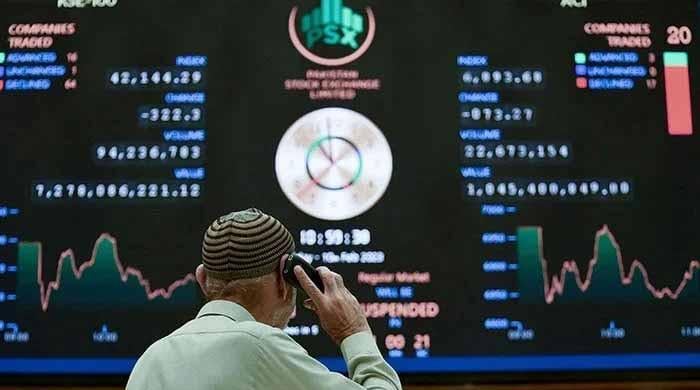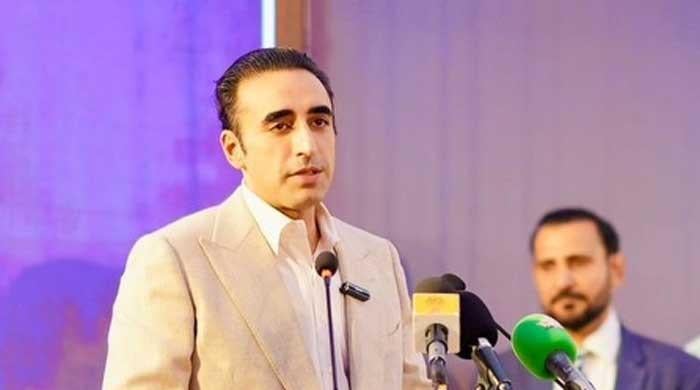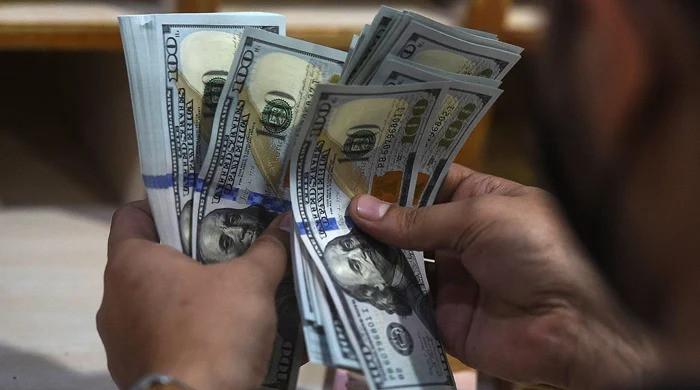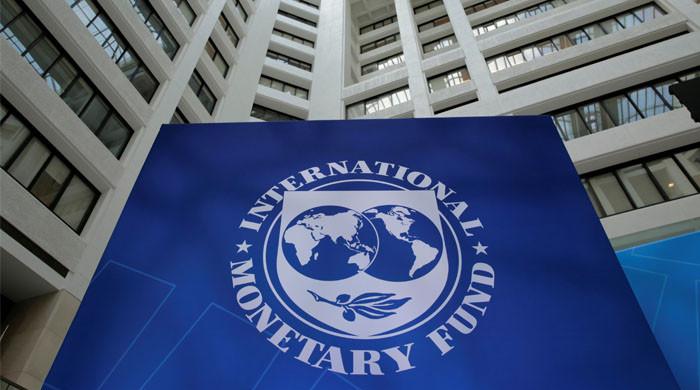Budget FY26: Govt eyes 4.2% GDP growth, proposes relief for salaried class
Rs17.5tr budget forecasts 3.9% deficit, 7.5% inflation, 4.2% growth
June 10, 2025
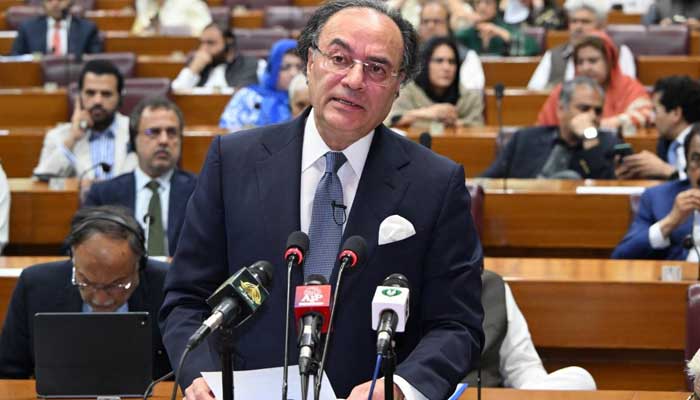
- Budget for FY-26 has a total outlay of Rs17.57 trillion.
- Inflation projected at 7.5%, economic growth at 4.2%.
- Tax collection target for FBR set at Rs14,131 billion.
ISLAMABAD: Minister for Finance and Revenue Muhammad Aurangzeb on Tuesday presented the federal budget for fiscal year 2025–26 with a total outlay of Rs17.57 trillion, setting a 4.2% GDP growth target and announcing relief measures for the salaried class while overall federal expenditure being slashed by 7%.
The budget session, chaired by NA Speaker Sardar Ayaz Sadiq, was marred by opposition's protest, with lawmakers chanting slogans against the Pakistan Muslim League-Nawaz (PML-N) government.
Starting his speech, Aurangzeb said he was honoured to present second budget for the incumbent government. He thanked Prime Minister Shehbaz Sharif, Bilawal Bhutto-Zardari, Khalid Maqbool Siddiqui and others for their support in the budget.
The finance minister said the federal budget being presented at an "extremely important and historic moment," while praising national unity during recent tensions with India.
"This budget comes at a pivotal time for our nation's future," he said, commending the country's military and political leadership for their "successful handling of recent war-like situation" with India.
“Pakistan has now achieved economic stability and is moving towards a Pakistan that is prosperous.”
He highlighted the current account surplus, remittances, and the stability of the rupee while also mentioning the positive reports from international credit rating agencies Moody’s and Fitch that upgraded Pakistan’s rating.
The federal budget for fiscal year 2026 has a total outlay of Rs17.573 trillion, representing a nearly 7% decrease from the previous year’s budget. It projected a deficit of 3.9% of GDP against the 5.9% targeted for 2024-25. Inflation was projected at 7.5% and growth at 4.2%.
Salient features
In his speech, FinMin Aurangzeb elaborated on the salient features of the budget, including economic growth, tax targets, PSDP allocations, and others.
- The estimated tax collection of the FBR would be Rs14,131 billion, with an 18.7% increase compared to the previous fiscal year. The part of provinces in the federal taxes would amount to Rs8,206 billion.
- Non-tax revenue target would be Rs5,147 billion.
- Federal government's net income would be Rs11,072 billion.
- Overall expenditures of the federal government are estimated at Rs17,573 billion of which Rs8,207 billion will be allocated for the mark-up payment.
- Federal government's current expenses are estimated at Rs16,286 billion.
- Rs1,000 billion allocated for the federal government's public sector development.
- Rs2,550 billion allocated for defence.
- Rs971 billion allocated for expenditures of civil administration.
- Rs1,055 billion allocated for pensions.
- Rs1,186 billion allocated for subsidies on electricity, and other sectors.
- Rs1,928 billion is allocated for grants for Benazir Income Support Programme (BISP), Azad Jammu and Kashmir (AJK), Gilgit-Baltistan, and newly merged districts of the Khyber Pakhtunkhwa (KP).
- Coverage of BISP flagship initiatives would be increased and Rs10 million families will be reached under the Kafalat programme.
- Educational scholarship programme will also be expanded and Rs12 million children will be benefited.
- Centre proposes Rs716 billion allocation for BISP for the new fiscal year with an increase of 21% compared to previous year.
- Govt proposes to allocate funds from ongoing expenses automous regions, KP districts and Balochistan, including Rs140 billion AJK, Rs80 for GB, Rs80 billion for KP's merged districts, and Rs18 for Balochistan.
"Those who were beating the drums about a mini-budget... no mini-budget has come, nor have any additional taxes been imposed," he added.
The South Asian nation wants to kickstart growth while boosting its defences after the worst fighting with its neighbour in nearly three decades and meeting the strictures of an International Monetary Fund finance programme.
'Achievements under PM Shehbaz'
FBR reforms
Recalling the achievements of Prime Minister Shehbaz-led government, he pointed out reforms in the Federal Board of Revenue (FBR), saying that Pakistan's tax-to-GDP ratio was only 10%. "It was imperative to increase the ratio to 14%," he said, adding that achieving the national targets was “impossible without the FBR's transformation.”
Detailing the transformation, he listed the initiation of digital integration in Pakistan's economy and tax system, digital production tracking, B2B e-invoicing, AI-based audit selection systems for sales and income tax, e-billing and faceless audits, and a new central control unit to centralise data collection.
Energy reforms
Aurangzeb said the government reduced the electricity rate by up to 31% for industrial sector, renewed agreements with indepedent power producers (IPPs), closed down power plants based on furnace fuel with capacity of 3,000 MW, reorganised the National Grid Company of Pakistan, among other steps.
The minister revealed that the Reko Diq copper and gold mines represent a vital asset for Pakistan's future, with an expected mining duration of 37 years. The project is projected to generate $75 billion for the national economy, he added.
He further said that infrastructure development linking Port Qasim to Gwadar via road and rail networks is already underway.
Tariff reforms
The minister said under the Comprehensive Tariff Reforms Package, custom duties will be eliminated within four years, regulatory duties will be phased out over five years and Fifth Schedule of the Customs Act 1969 will be abolished within five years.
"Reforms aim to enhance Pakistan's export competitiveness through streamlined tariff structures," he added.
Furthermore, he said that customs duties will now be limited to just four slabs: 0%, 5%, 10%, and 15%. The minister emphasised that these tariff reforms would be implemented gradually to ensure a smooth transition for businesses.
Key sectors set to benefit include pharmaceuticals, information technology, telecommunications, textiles, and engineering. "Our economy has been trapped in a cycle of debt for the past two decades," Aurangzeb stated. "These reforms mark a decisive shift towards sustainable growth by lowering production costs and boosting exports."
The finance minister also revealed progress on capital market initiatives, including the recent issuance of Sukuk bonds through the Pakistan Stock Exchange and the completion of preparations for the country's first Panda bond.
Aurangzeb noted that Special Economic Zones (SEZs) alone cost the national exchequer more than Rs800 billion annually.
GDP expected to grow 4.2%
Speaking about the allocations in the Finance Bill 2026, the finance minister said the federal budget for fiscal year 2025-26 marks the beginning of a comprehensive strategy to build a competitive economy.
Aurangzeb noted that the country's GDP expected to grow 4.2% while inflation's average ratio likely to remain at 7.5% in the next fiscal year. "Budget deficit to be 3.9% of country's GDP while primary surplus will be 2.4%."
"This budget is designed to boost exports, strengthen foreign exchange reserves, address payment imbalances, and enhance economic productivity," he said. The minister emphasised that the government aims to implement fundamental reforms to "transform the very DNA of our economy" through structural changes.
The budget deficit has been contained at 3.9% of GDP, while a primary surplus of 2.4% of GDP has been achieved – reflecting improved fiscal discipline.
Meanwhile, the FBR has projected tax revenue of Rs14,131 billion for FY2025-26, representing an 18.7% increase from the current fiscal year, the finance minister said.
Of this amount, Rs8,206 billion will be allocated to provinces as their constitutional share in federal taxes, he added.
On the non-tax revenue front, the government has set an ambitious target of Rs5,147 billion, reflecting efforts to optimise income from state-owned enterprises and other non-tax sources. After accounting for provincial transfers, the federal government's net revenue is estimated at Rs11,072 billion.
The total federal expenditure has been budgeted at Rs17,573 billion, with Rs8,207 billion earmarked for debt servicing — a critical component that underscores the government's commitment to fiscal responsibility.
In terms of sectoral allocations:
- Defense remains the top priority with Rs2,550 billion allocated to safeguard national security.
- Civil administration receives Rs971 billion for smooth governance operations
- Pension expenditures are budgeted at Rs1,055 billion
- Subsidies, particularly for the power sector, have been allocated Rs1,186 billion to ease the burden on consumers and support key economic sectors.
PSDP
Referring to the sector-wise allocations, Aurangzeb noted that the Federal Public Sector Development Programme (PSDP) serves as a critical vehicle for mobilising both domestic and foreign resources to drive growth across various economic sectors.
Keeping in view the current fiscal constraints, the National Economic Council (NEC) has approved Rs4,224 billion for national development expenditure in FY2025-26.
This includes:
- Rs1,000 billion for Federal PSDP
- Rs2,869 billion for Provincial Annual Development Programs (ADPs)
- Rs355 billion in self-financed investments by State-Owned Enterprises (SOEs)
According to the minister, the FY2025-26 Federal PSDP prioritises basic infrastructure projects, allocating over 60% of resources to ensure nationwide benefits.
In contrast, Provincial ADPs emphasise social sectors, dedicating more than 60% of their funds accordingly. This distribution pattern clearly reflects the implementation of responsibilities under the 18th Constitutional Amendment.
The development portfolio has been carefully aligned with flagship national programmes including, Uraan Pakistan and ES-5.
Higher education
According to the minister, the federal government has allocated Rs39.5 billion under the PSDP for the 128 ongoing and 12 new schemes of the Higher Education Commission (HEC) during the fiscal year 2025-26.
Among the ongoing schemes, an amount of Rs500 million is allocated for the Award of Allama Muhammad Iqbal 3000 scholarships to Afghan students, while Rs200 million have been reserved Construction of Academic Block, Shaheed Zulfiqar Ali Bhutto Medical University (SZABMU), Islamabad.
Similarly, Rs250 million have been allocated for the development of Main Campus, Bacha Khan University, Charsadda and Rs500 million for development of National University of Medical Sciences (NUMS), Rawalpindi.
Furthermore, Rs611 million have been reserved for establishment of Kamyab Jawan Sports Academies (High Performance & Resource Centers) and Youth Olympics – HEC, Rs558 million for establishment of University of Baltistan at Skardu.
An amount of Rs100 million has also been allocated for Fulbright Scholarship Support Program HEC-USAID (Phase-III), while Rs2300 million are reserved for Overseas Scholarship for MS/MPhil leading to Ph.D. in selected fields (Phase III) – HEC, Rs3670 million allocated for Ph.D Scholarship Program under Pak-US Knowledge Corridor (Phase-I)-(Revised).
Among new schemes, the government has allocated Rs50 million reserved for Allama Muhammad Iqbal Scholarships for Bangladesh, Uzbekistan, and Friendly Countries-HEC, Rs100 million for establishing a campus of Pakistan Institute of Fashion Design at Karachi.
Similarly, Rs150 million have been earmarked for University Campus at Muzaffargarh and UVAS Campus Pattoki with Rs150 million.
Agriculture sector
Rs4.2 billion has been allocated for the development of the country's agriculture sector, said Aurangzeb, adding that in the fiscal year 2025-26, special attention will be given to the revival of cotton crops and livestock alongside special training programmes.
Aurangzeb said that the Centre is taking concrete steps for the agriculture sector — contributing a significant portion to the country's GDP — including the Green Pakistan Initiative for adopting improved and modern techniques of farming and expanding cultivable land.
It also focused on other initiatives, including capacity building, productivity, crop diversification, genetic improvement, post-harvest processes, and access to markets.
The allocation under the Public Sector Development Program (PSDP) will be spent on different uplift projects of the Ministry of National Food Security and Research in order to develop the local agriculture and livestock sector.
According to the PSDP 2025-26, an amount of over Rs1 billion was earmarked for five new and Rs3.2 billion for 10 ongoing development projects.
The government allocated Rs585 million for the national programme for enhancing command areas in Barani areas of Pakistan and Rs500 million for the national oilseed development program.
Rs450 million has been allocated for the national agriculture productivity enhancement programme and Rs100 million for the Pakistan model agriculture research centre.
For ongoing schemes, the government has allocated Rs257 million for the Pak-Sar-Zameen card, Rs125 million for reviving cotton, Rs200 million for the financial incentive program for sustainable agri-business and aquaculture development.
Circular Debt
Referring to the energy sector's circular debt, the finance minister said that the government has unveiled a comprehensive plan to address Pakistan's crippling energy sector circular debt, which ballooned to Rs2,393 billion by the end of last fiscal year.
"This unsustainable debt burden currently incurs additional financial charges ranging between 2% to 5.4% above KIBOR, with projected servicing costs reaching Rs454 billion in FY2025 alone," he said.
"The federal government plans to replace existing expensive debt with Sharia-compliant bank financing through a strategic refinancing approach," the minister said, adding that this "solution" will utilise the Debt Servicing Surcharge (DSS) not just for profit/markup payments but also for principal debt repayment – a significant departure from current practices.
EV policy
Meanwhile, the FinMin announced that the government has formulated a new Electric Vehicle (EV) Policy aimed at promoting the use of two- and three-wheeled electric vehicles (EVs) over traditional petrol and diesel-powered vehicles.
"This initiative seeks to reduce environmental pollution while decreasing the country's reliance on imported fossil fuels," he added.
Highlighting the key features of the EV Policy, he said that the policy encourages the manufacturing and sale of electric two- and three-wheelers by introducing a levy on petrol and diesel vehicles.
The levy will be applied at varying rates based on engine power, affecting both local sales and imports of fossil fuel-based vehicles.
Health sector
The government has allocated Rs14.3 billion for completion of health sector projects under the PSDP for the fiscal year 2025–26.
According to the official budget document, the allocation was made with a strategic focus on improving healthcare infrastructure, disease surveillance, preventive medicine, maternal care, and emergency preparedness across the country.
An amount of Rs4 billion has been allocated for Jinnah Medical Complex and Research Centre, Islamabad, while Rs1 billion was allocated for the Prime Minister's Hepatitis C Eradication programme.
The government has also allocated an amount of Rs2 billion for the development of the Integrated Disease Surveillance and Response System (IDSRS).
Furthermore, Rs1.7 billion was allocated for the establishment of a cancer hospital in Islamabad.
An amount of Rs900 million has been allocated for the procurement of equipment for the federal capital's cancer hospital in federal capital.
Moreover, Rs900 million will be spent on the establishment of stroke intervention and expansion of critical care and cardiac facility at the Pakistan Institute of Medical Sciences (PIMS).






